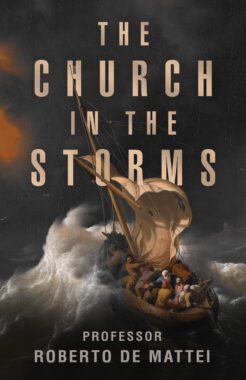A Reflection from “The Church in the Storms” by Roberto de Mattei
Christianity and the Roman Empire
We live in an age of crisis in every sense: economic crisis, political crisis, and above all spiritual and moral crisis. 22 These latter crises are what here interest us most; they touch our lives, because we are not only bodies, as the majority of people believe and practice, but bodies ineluctably animated by souls. The soul is not only the more noble part of our being, but that which gives life to our being, the reason why we live and breathe. We have a soul, and so we have, or ought to have, a spiritual life. This spiritual life is born from the gift of faith infused in us at baptism and nourished by grace communicated through the sacraments of the Church. All that concerns the Church touches our faith, and what touches our faith has consequences for our soul and for those who are dear to us. For this reason, we must attentively consider the Church and its history, because understanding what happened yesterday helps us to live today.
When we speak of the Church, we must remember that there are actually three Churches that form a whole: the Church Militant formed by all the baptized who profess the same faith under the same pastors; the Church Suffering, composed of all the deceased being purified in Purgatory, awaiting their entrance into Paradise; and finally, the Church Triumphant, formed by the saints who already live in the eternal joy of the divine glory. Together, these three realities form the communion of saints, a dogma we profess in our creed.
To understand the history of the Church, not only yesterday or two thousand years ago, but also, and above all, today, we must keep our minds fixed on the word “militant.” The Church Militant means a Church that is “fighting.” St. Paul explains in many passages in his letters how the life of a Christian is a bonum certamen, a good fight that must be waged “as a good soldier of Jesus Christ” (2 Tim. 2:3). He says, “Let us cast off the works of darkness and put on the armor of light” (Rom. 13:12). The Church on earth suffers, certainly, but most of all it fights. It suffers both when it wages its warfare and because of it; however, for the Church and for Christians, the time of suffering is in Purgatory more than here on earth. We were not born to suffer, but to fight and to win, although suffering accompanies us our entire life. We must not, however, be satisfied with this suffering, because it is the consequence of sin. Life on earth is a struggle, a struggle between two cities, the City of God and that of the devil, between the Church and her enemies who, as St. Augustine says in the City of God, wage war until the end of time.
We would like, then, to recall the most important episodes of this combat that is renewed every day, and in which we must not be spectators but protagonists. We must imagine the world as a great theater, with the angels in Heaven as spectators and, in the gallery of honor, Jesus and Mary. Let us choose then to play our part, studying the script of history.
Let us begin by speaking of the early centuries of the Church, so far away, but also very near. Those centuries were a period of persecution and martyrdom and were also for this reason a period of fighting. The fight was first conducted by the apostles, and then by their successors, to carry out the mandate of Christ, which was to spread the gospel to the ends of the earth.
In that moment, Christianity stood before the Roman Empire, the largest empire history had ever known. Christianity and the Roman Empire were the same age, so to speak, because while the history of Rome began 753 years before Christ with the foundation of the city by Romulus and Remus, the birth of the empire was the work of Augustus, under whose reign Jesus was born in Palestine.
The Roman Empire and nascent Christianity stood in opposition, engaging in a relentless conflict devoid of all agreement or compromise. This war was not declared by Christianity but by the empire, which did not tolerate the presumption of absolute truth on the part of Christianity, nor its message of radical and integral salvation.
The first great clash was the trial of Jesus, promoted by the Jews in their Sanhedrin, and brought before Pilate, who represented the Roman Empire and who surrendered Christ to his executioners. This is not the place to discuss whether he bore greater responsibility than those who betrayed Jesus to him, fomenting him. What is important to emphasize is that Jesus wanted to show from the very beginning that, between the Church and the world, there exists a radical incompatibility. The Passion and death of Jesus were to be the model of all physical pain and suffering, but especially spiritual and moral suffering, which Christians would have to endure throughout their history.
The Roman Empire not only condemned Jesus through the hand of Pilate; after Pilate was removed from Palestine, the empire continued to condemn Christ, refusing to give Christianity the status of religio licita, a legal religion in the empire.
The persecution against Christians began in Palestine with the lapidation of Stephen, desired by Caiaphas in 34, then with the death of James of Zebedee, the first martyr among the apostles, sent to his death by King Herod Agrippa I. The apologists speak of a report that the emperor Tiberius (14–37) requested of the procurator in Galilee, Pontius Pilate, after these events. According to Tertullian, Pilate’s report would have pushed Tiberius to propose that the Senate recognize the divinity of Jesus and grant Christianity the status of religio licita, but the Roman Senate rejected it. The Roman senatorial aristocracy, from the very beginning, displayed its aversion toward Christianity by fomenting persecutions against it, especially in the highest spheres of society, while popular antipathy was stoked by the Jews, as the Acts of the Apostles recalls (19:33ff.).
To purchase this book, please visit one of the links below.
_

This article on ‘Rome May Have Fallen, But The Church Never Will’ is adapted from the book The Church in the Storms by Roberto de Mattei which is available from Sophia Institute Press.
Art for this post on a reflection from “The Church in the Storms” by Roberto de Mattei; cover used with permission; Photo used in accordance with Fair Use practices.




